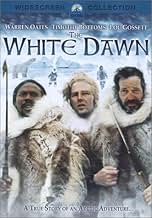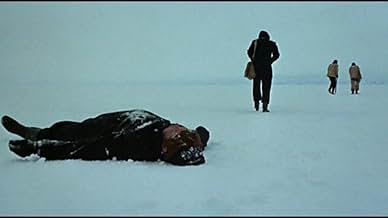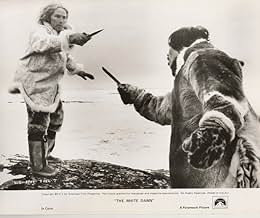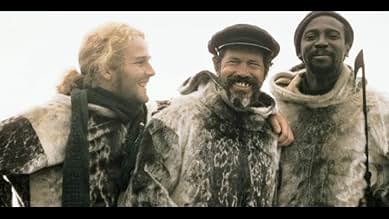En 1896, tres supervivientes de un naufragio ballenero en el Ártico canadiense son salvados y adoptados por una tribu esquimal, pero surgen fricciones cuando los tres empiezan a portarse mal... Leer todoEn 1896, tres supervivientes de un naufragio ballenero en el Ártico canadiense son salvados y adoptados por una tribu esquimal, pero surgen fricciones cuando los tres empiezan a portarse mal.En 1896, tres supervivientes de un naufragio ballenero en el Ártico canadiense son salvados y adoptados por una tribu esquimal, pero surgen fricciones cuando los tres empiezan a portarse mal.
- Dirección
- Guionistas
- Elenco
Louis Gossett Jr.
- Portagee
- (as Lou Gossett)
Ann Meekitjuk Hanson
- Neevee
- (as Pilitak)
Opiniones destacadas
This little-known film of Philip Kaufman's is a look at a culture not seen much in films, that of the Innuit, or Eskimo people of Arctic Canada. Three whalers (Warren Oates, Timothy Bottoms and Louis Gosset Jr.) are stranded among them after a shipwreck. The year is 1896 but it could just as well be 1996 or 1796 as far as we can tell in this simple world where survival against nature is always the biggest concern. Surprisingly to me, the culture clash does not seem to be that great through most of the movie, and when it comes, it does so rather quickly. I think this makes for a less strong film but it's still an interesting one that really fascinates at times.
Cinematographer Michael Chapman ('Raging Bull') provides some great shots of the Great White North and Henry Mancini's score is very nice also. Martin Ransohoff is usually known as a producer but co-wrote the script here with Thomas Rickman.
Cinematographer Michael Chapman ('Raging Bull') provides some great shots of the Great White North and Henry Mancini's score is very nice also. Martin Ransohoff is usually known as a producer but co-wrote the script here with Thomas Rickman.
"The White Dawn" unfolds at a pace that I'm pretty sure many young people will be turned off by. There isn't really much of a plot here, for starters, and the movie unfolds at a pretty leisurely pace. Also, there isn't a terrible about of development for the characters played by Oates, Bottoms, and Gossett. But I have to admit that despite all that, I found the movie fairly captivating. The movie is slow, but it has a kind of hypnotic spell that kept me watching. Also, the depiction of the Inuit seems pretty authentic - I'm no expert on Inuit culture, but it sure seemed authentic. (One interesting detail is that it shows that the Inuit didn't have some sort of paradise lifestyle - they had problems like starvation, for example.) If you are looking for a movie that is quite different than usual - both in its subject matter and its telling - this movie is worth a look.
have some respect for and knowledge of tribal cultures where the shamans have authority, the people are "tuned in" to the natural world, and "nature magic" is understood on a gut level by everyone from childhood onward. I saw this film many years ago and loved it; it's still excellent. If you like it, you may want to read "The Heart of the Hunter" by Laurens Van Der Post, a classic about the Bushmen in South Africa. This film will be of value to anyone who has someone in their family who's made a mess of his or her life because of alcohol. Grab the drinker and make him or her watch it and that person may get a sense for how destructive that behavior is. Anyone who wants to learn about the Bear Spirit will learn something here as well.
Looking back from the 21st century, it is obvious that from the moment Columbus set foot in the new world the indigenous peoples of the Americas were doomed. It is equally obvious to a thoughtful viewer from 2005 that a movie made in 1973 about three shipwrecked whalers who are rescued by a band of Inuit and the resulting culture clash is going to end in tragedy. I knew the conclusion of "The White Dawn" as soon as I read two sentences of it's description on Netflix.
But we shouldn't really hold that against it. Because "The White Dawn" is a very good movie and I am shocked that more movie aficionados haven't heard of it. I never did, and I am a fan of Philip Kaufman and Timothy Bottoms and movies of the 70s, and I have an interest in the arctic. This movie seems to have been buried under a rock somewhere, despite fine performances all around, beautiful cinematography and direction, and fascinating subject matter in the Eskimos.
Filmed on location on Baffin Island in what is now Nunavet, the Inuit territory of Northern Canada, "The White Dawn" portrays the story of the three whalers - Timothy Bottoms, Louis Gossett Jr, and Warren Oates as they live with a sympathetic and friendly Inuit band over the course of a year, and how ultimately the interaction of the two world views leads to tragedy. It is based on the novel of the same name by James Houston, who lived with the Inuit for many years and based his novel on stories handed down through the generations of an actual event of 1897. In a fine performance, Bottoms is sensitive and open to the Eskimo way of life, falling in love with the woman Neevee. On the other hand is arrogant and exploitive Oates, who comes to represent the worst of "civilized" man's attitudes towards the Eskimo. He is dramatically counterbalanced by the equally manipulative Inuit Shaman, who pronounces that the whalers are bringing evil to the band of Eskimos.
While the ending might seem preordained, "The White Dawn" is full of texture as it examines the meeting of cultures. And beyond the story itself, it is full of vivid and powerful images of Eskimo life, presented with apparently absolute realism by the amateur (but very good) Inuit cast. The joys and sorrows of the native's communal life are conveyed as they travel and hunt through the seasons. The highlights of the movie include a seal hunt, later a more desperate walrus hunt, and a winter dance in a large igloo, featuring the strange and wonderful throat chanting of two Inuit girls.
A note for animal lovers - according to the commentary track, while seals and walruses were killed in filming, they were only killed if they would have been killed anyway, and the slain animals were completely utilized for food and fur by the Inuit (who do still hunt and rely on seals). The polar bear used in filming was not injured in any way.
If you are a fan of the cinema of the 70s or movies in general, and are willing to accept the grim nature of the story, I highly recommend "The White Dawn". Certainly it should gain a wider audience and not be forgotten.
But we shouldn't really hold that against it. Because "The White Dawn" is a very good movie and I am shocked that more movie aficionados haven't heard of it. I never did, and I am a fan of Philip Kaufman and Timothy Bottoms and movies of the 70s, and I have an interest in the arctic. This movie seems to have been buried under a rock somewhere, despite fine performances all around, beautiful cinematography and direction, and fascinating subject matter in the Eskimos.
Filmed on location on Baffin Island in what is now Nunavet, the Inuit territory of Northern Canada, "The White Dawn" portrays the story of the three whalers - Timothy Bottoms, Louis Gossett Jr, and Warren Oates as they live with a sympathetic and friendly Inuit band over the course of a year, and how ultimately the interaction of the two world views leads to tragedy. It is based on the novel of the same name by James Houston, who lived with the Inuit for many years and based his novel on stories handed down through the generations of an actual event of 1897. In a fine performance, Bottoms is sensitive and open to the Eskimo way of life, falling in love with the woman Neevee. On the other hand is arrogant and exploitive Oates, who comes to represent the worst of "civilized" man's attitudes towards the Eskimo. He is dramatically counterbalanced by the equally manipulative Inuit Shaman, who pronounces that the whalers are bringing evil to the band of Eskimos.
While the ending might seem preordained, "The White Dawn" is full of texture as it examines the meeting of cultures. And beyond the story itself, it is full of vivid and powerful images of Eskimo life, presented with apparently absolute realism by the amateur (but very good) Inuit cast. The joys and sorrows of the native's communal life are conveyed as they travel and hunt through the seasons. The highlights of the movie include a seal hunt, later a more desperate walrus hunt, and a winter dance in a large igloo, featuring the strange and wonderful throat chanting of two Inuit girls.
A note for animal lovers - according to the commentary track, while seals and walruses were killed in filming, they were only killed if they would have been killed anyway, and the slain animals were completely utilized for food and fur by the Inuit (who do still hunt and rely on seals). The polar bear used in filming was not injured in any way.
If you are a fan of the cinema of the 70s or movies in general, and are willing to accept the grim nature of the story, I highly recommend "The White Dawn". Certainly it should gain a wider audience and not be forgotten.
Full disclosure I only watched this film because I admire Warren Oates and I had recently watched The Paper Chase and enjoyed Timothy Bottoms in that movie. I had only a vague notion of the theme of White Dawn and checked it out from my local library.
To begin I disapprove of seeing this film as good vs bad or savage vs civilized. I see far too many summaries of this film through that lens. The story, evidently, based on real events and was subject of a novel of the same name White Dawn, tells of four men who were part of an American whaling vessel in the Baffin Bay and while on a whale hunt are wrecked and stranded on the Baffin Island. The ship thinking those men dead turn about and sail home. One of the four stranded men died early on and we know nothing of him. The three remaining men struggle across the frozen barren until fortuitously they are discovered by some Inuits. The men are taken in and fed and provided shelter. Over time the men are initially given respect and are given wives, although Oates character is a devious man who wins his wives in a game. Naturally there are cultural misunderstandings and this eventually turns to friction. The Inuits are occasionally visited by a shaman who warns the tribe the newcomers are trouble. Somewhat a slow film but it builds to a tragic end.
The film is beautifully shot. We see a seal and walrus hunt and it appears to give an authentic look at Inuit life. I say appears because I am no authority on the Inuits, but the author of the novel, James Houston, on which the film was based lived with the Inuits to learn their ways, so I am trusting his observations. We see the Inuit life is hard and simple. It alludes the Inuits occasionally suffer from starvation. The film was shot on location where the events happened. You get a sense of the isolation of the place.
Overall I enjoyed the film, mainly because I was fascinated with a look at a people oftentimes forgotten and of the location which is isolated and formidable. Oates, Gossett and Bottoms deliver great performances.
To begin I disapprove of seeing this film as good vs bad or savage vs civilized. I see far too many summaries of this film through that lens. The story, evidently, based on real events and was subject of a novel of the same name White Dawn, tells of four men who were part of an American whaling vessel in the Baffin Bay and while on a whale hunt are wrecked and stranded on the Baffin Island. The ship thinking those men dead turn about and sail home. One of the four stranded men died early on and we know nothing of him. The three remaining men struggle across the frozen barren until fortuitously they are discovered by some Inuits. The men are taken in and fed and provided shelter. Over time the men are initially given respect and are given wives, although Oates character is a devious man who wins his wives in a game. Naturally there are cultural misunderstandings and this eventually turns to friction. The Inuits are occasionally visited by a shaman who warns the tribe the newcomers are trouble. Somewhat a slow film but it builds to a tragic end.
The film is beautifully shot. We see a seal and walrus hunt and it appears to give an authentic look at Inuit life. I say appears because I am no authority on the Inuits, but the author of the novel, James Houston, on which the film was based lived with the Inuits to learn their ways, so I am trusting his observations. We see the Inuit life is hard and simple. It alludes the Inuits occasionally suffer from starvation. The film was shot on location where the events happened. You get a sense of the isolation of the place.
Overall I enjoyed the film, mainly because I was fascinated with a look at a people oftentimes forgotten and of the location which is isolated and formidable. Oates, Gossett and Bottoms deliver great performances.
¿Sabías que…?
- TriviaAccording to producer Irwin Winkler, this movie was the main factor in his decision to invite director Philip Kaufman to direct Los elegidos (1983). Portions of Henry Mancini's score for this film can be heard in the later film.
- Versiones alternativasThe film was originally given an "R" rating from the MPAA due to the nudity which was then edited for the film to receive a "PG" rating.
- ConexionesReferenced in Realizing 'The Right Stuff' (2003)
Selecciones populares
Inicia sesión para calificar y agrega a la lista de videos para obtener recomendaciones personalizadas
- How long is The White Dawn?Con tecnología de Alexa
Detalles
- Fecha de lanzamiento
- País de origen
- Idioma
- También se conoce como
- Die weiße Dämmerung
- Locaciones de filmación
- Productoras
- Ver más créditos de la compañía en IMDbPro
Taquilla
- Presupuesto
- USD 1,700,000 (estimado)
Contribuir a esta página
Sugiere una edición o agrega el contenido que falta

Principales brechas de datos
By what name was The White Dawn (1974) officially released in India in English?
Responda






















